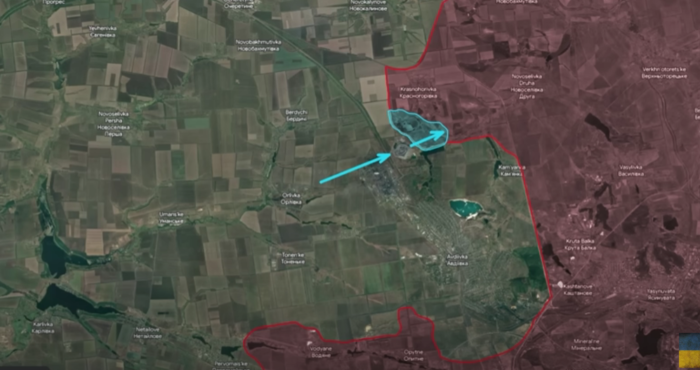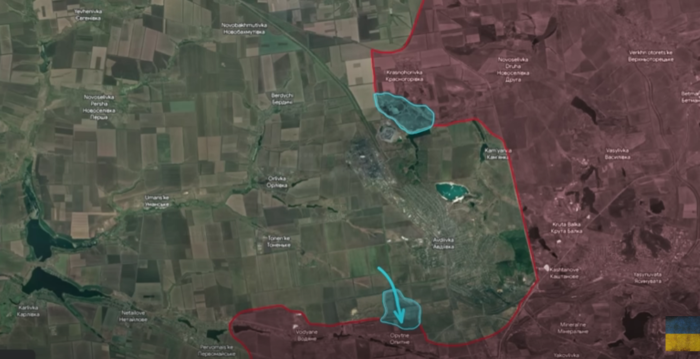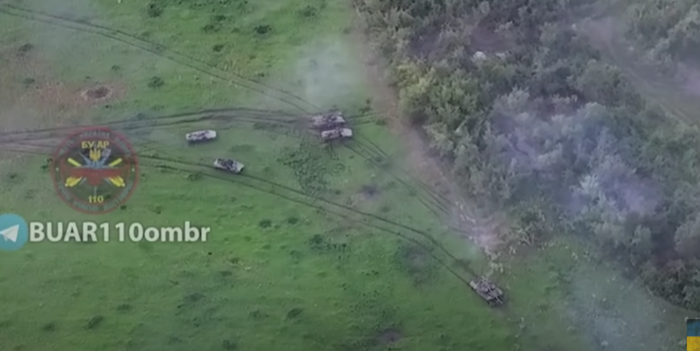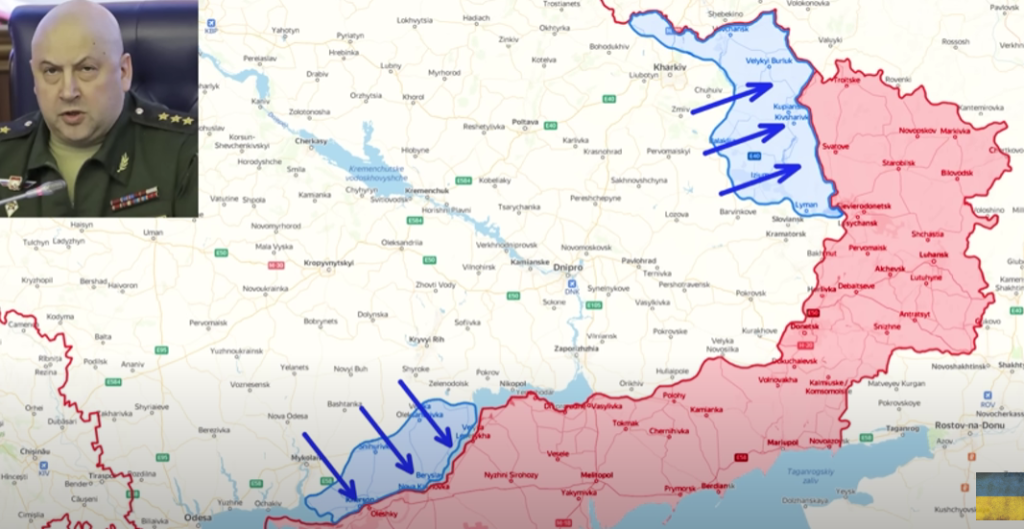As of 10 July, there is plenty of news from the Avdiivka direction. Over the past several weeks, Ukrainians have capitalized on the diminished attention of the Russian forces in Donetsk Oblast and have conducted a series of counterattacks.
The first axis of the Ukrainian advance was Krasnohorivka. Ukraine’s goal was to clear the tree lines in front of Terrikon, thereby setting the stage for the potential development of the counterattack and undermining the Russian positions in Krasnohorivka. The counterattack went successfully, and Ukrainians advanced by up to 1 km.

Screenshot from the video: Ukraine’s counterattack in Krasnohorivka direction
The final counteroffensive attack was to take a Russian stronghold right near the eastern edge of the reservoir. Ukrainian defenders were assaulting early in the morning, approaching the Russian fortification undetected. However, the closer the Ukrainians got, the higher the risk of detection became. Eventually, the Russians noticed the movement and retaliated, pinning the Ukrainian troops in the tree line.
Ukrainian artillery promptly responded to this development by suppressing the Russian fire, allowing Ukrainians to cover the remaining distance and enter the trenches. Following this, Ukrainian forces took some time to regroup.
Ukrainian commanders identified an opportunity in the southern part of the Donetsk Oblast and decided to recapture several positions in front of Opytne, where Russian defenses were weak. This operation was also successful, and Ukrainians reached the outskirts of Opytne.

Screenshot from the video: Ukraine’s counterattack in Opytne direction
Ukrainian commanders attempted a similar feat in front of Vodiane, but Russians suddenly hit them from the opposite direction.
Ukrainian commanders reported that Russian forces deployed 21 armored vehicles of various types. Based on the video footage, Russians deployed at least three assault units, each consisting of one or two tanks and four or five armored fighting vehicles. The tanks advanced first, attempting to suppress Ukrainian fire while undermining and demolishing the recaptured fortifications by the Ukrainians.

Screenshot from the video: a battle between Ukrainian defenders and Russian soldiers
Unfortunately for the Russians, the Ukrainian 110th Mechanized Brigade never vacated their positions. Ukrainians unleashed artillery fire and engaged their most skilled drone operators to target Russian vehicles. As a result, Ukrainian defenders destroyed Russian tanks and armored fighting vehicles. Russians lost approximately 200 soldiers in action.
This was the most disastrous Russian attack since Vuhledar, with the only difference being that this time, the Russians did not advance an inch. [Over 1,000 Russian troops were killed and an entire Russian brigade was “annihilated” during two daysduring Russia’s failed assault on the Donetsk Oblast city of Vuhledar, Ben Wallace, the British Secretary of State for Defence, said on 15 February. After this disastrous failure, Russians attempted low-scale assaults at the city but were unable to advance. Ukrainian officials assess that 130 Russian tanks and APCs were destroyed in the battle for Vuhledar – Ed.]
On 15 February,, said that over 1,000 Russian troops had been killed over just two days, and that an entire Russian brigade had effectively been “annihilated”
Meanwhile, in order to indirectly address the speculations of the removal of the Russian Chief of the General Staff, Gerasimov, from the position of the commander of the so-called “special military operation,” Gerasimov conducted a meeting with the main topic being the war in Ukraine. However, instead of dispelling all doubts about the intactness of the Russian Ministry of Defense, it gave rise to even more speculations.
People noticed that the Russian Air Force was represented by Afzalov instead of Surovikin. It’s been widely speculated that Surovikin was dealing with charges of treason because he secretly supported the Wagner coup.
Earlier, Surovikin was appointed commander of the so-called “special military operation” right when the front lines started collapsing during the Ukrainian counteroffensive operations in the Kharkiv and Kherson Oblasts. He was essentially made the captain of a sinking ship, and he was supposed to take the blame for everything.

Screenshot from the video: Surovikin, appointed commander of the so-called special military operation after Russia’s collapsing during the Ukrainian counteroffensive operations in the Kharkiv and Kherson regions.
However, he stopped the collapse of the front line in the Luhansk Oblast and started building an extensive defense line in the south, which Ukrainians are dealing with right now. When the Russian Ministry of Defense saw that the situation stabilized, Gerasimov assumed the top position while putting Surovikin in charge just of the Air Force, and now we saw that Afzalov, not Surovikin, represented the Air Force.
























0 comments:
Post a Comment